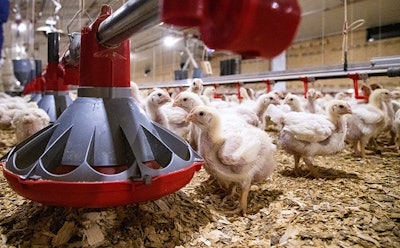
Tyson Foods and the University of Arkansas System Department of Agriculture have teamed up for a joint project studying the health effects of lighting on poultry.
“Light intensity has an impact on bird activity and that activity can impact welfare. For example, if the birds in bright light are anxious and feel like they need to flee, they could potentially be injured or injure other birds. Lights that are too bright can impact how efficiently they convert feed to muscle. Too much activity will require more feed just to support that activity," Karen Christensen, Ph.D., senior director of animal welfare for Tyson Foods and primary investigator for their animal welfare research, said.
"From a sustainability perspective, we are trying to find the balance between encouraging voluntary activity, welfare and efficient usage of resources, like feed. That is why we take a holistic look at our research and include the birds in the conversation."
Christensen will collaborate with Seong Wook Kang, poultry research associate for the Arkansas Agricultural Experiment Station, the research arm of the University of Arkansas Division of Agriculture, on the project, which will focus on the creation of objective measures that evaluate how light sources and intensity impact broiler welfare.
Correlation between light, welfare
Most experts agree that more light can increase stimulation and bird activity in the house, although further research is needed to assess exactly what kind of light (including intensity and color) has the optimal effect on poultry behavior and well-being.
"There is a lot of interest in how light-intensity is used in broiler houses. But overall, scientific research on light intensity and how it impacts broiler welfare has been an area of opportunity for the industry," explained Christensen.
"This research project will last for two years and will be conducted in the new state-of-the-art Broiler Welfare Research Facility at Tyson. This farm was built for the specific purpose of conducting trials in broiler welfare. The four houses are similar to the broiler houses contract growers use to raise birds for Tyson. Learnings from the new facility could transfer to commercial houses. It is a bit unique to be doing a study like this in a commercial facility, but it is important that we understand how research transfers to the real world.:
Funded by USPOULTRY
The project is funded by a $110,000 grant from the U.S. Poultry and Egg Association (USPOULTRY).
“The Center of Excellence for Poultry Science is excited to work directly with Dr. Christensen and Tyson Foods on this project,” said David Caldwell, director of the University of Arkansas Division of Agriculture’s Center of Excellence for Poultry Science. “The funding of this critical research emphasizes the entire industry’s commitment to, and their recognition of the importance of animal well-being in animal agriculture.”
Research projects are selected by USPOULTRY for funding twice a year. More than 50 universities and federal and state facilities have received grants since the inception of the program, resulting in more than $32 million in funding.
Like what you just read? Sign up now for free to receive the Poultry Future Newsletter
















